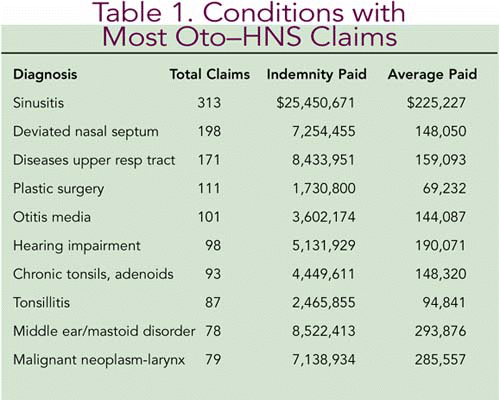The four most prevalent and expensive conditions that account for more than $1.7 billion, or nearly 15% of the total indemnity paid, are the brain-damaged infant, breast cancer, pregnancy, and acute myocardial infarction.
Explore This Issue
June 2007
Oto-HNS Indemnity Rising
Interestingly, the growth in ear, nose, and throat indemnity in the past eight years shows a rapidly expanding problem, Dr. Dawson said. Since 1999, over $103 million in added plaintiff compensation has nearly doubled the oto-HNS total indemnity accrued during the first 15 years of PIAA reporting.
Most malpractice claims are categorized under PIAA reporting by medical misadventures or alleged departures from accepted practice. The latter includes such categories as improper performance, errors in diagnosis, failure to monitor, failure to recognize complications, and procedures or treatment performed when not indicated.
In oto-HNS, the 10 most prevalent diagnoses or conditions with claims and indemnity paid are shown in Table 1.
Of these, 51% of the claims were in the area of rhinology, with indemnity paid representing 70.3% of all payments.
The 10 most expensive procedures, in order by indemnity, were:
- Operative procedures on the nose;
- Diagnostic interviews and evaluations;
- Operative procedures on paranasal sinuses;
- Operative procedures on middle ear/mastoid;
- Operative procedures on tonsils and adenoids;
- Prescription of medicines;
- Operative procedures on larynx and trachea;
- Operative procedures on skin;
- Operative procedures on salivary glands;
- Diagnostic procedures regarding the larynx.
Although some may believe that medical malpractice suits tend to affect poorly trained or less experienced physicians, the study found that oto-HNS physicians facing litigation were predominantly older (60% older than age 45), board certified (85%), and graduates of US medical schools (76%).
According to Drs. Dawson and Kraus, many rhinology claims contained issues of informed consent and documentation. Dr. Dawson noted that 37% of all claims involving endoscopic sinus surgery (ESS) involved informed consent, and 16% of all oto-HNS claims centered on informed consent.
Lessons to Be Learned
The take-home message was to strengthen informed consent to reduce risk. Noting that some individuals recommend that physicians create individual, customized check-off forms for every patient, Drs. Dawson and Kraus provided their suggestions for informed consent:
- Discuss reasons and need for treatment;
- The outcome if treatment is refused;
- The outcome if it is successful (including limitations and benefits);
- Risks associated with treatment;
- Alternative treatment and outcomes (including getting a second opinion); whether or not the treatment is experimental or controversial; and
- The physician’s own experience with the treatment.
Last, and most important, document everything, Dr. Dawson advised.

Leave a Reply